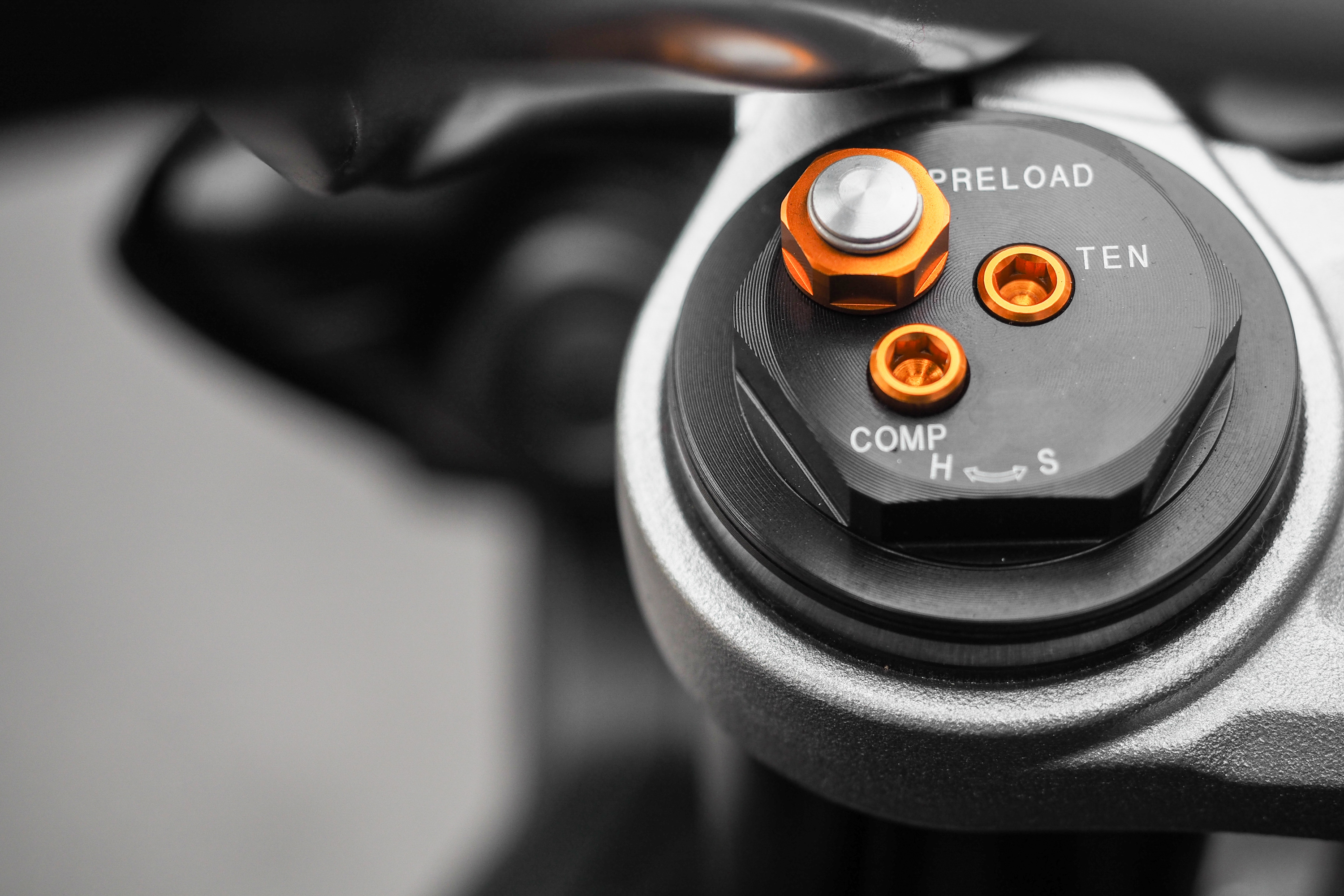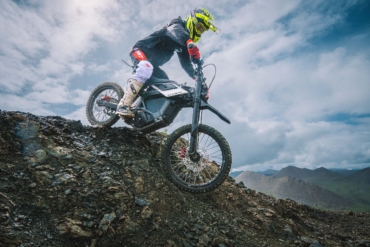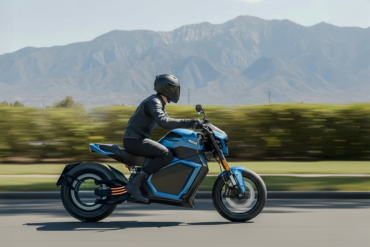Proper suspension setup is important for safety and fun on a motorcycle, especially when adventure touring.
Motorcycle suspension has a threefold role. For one, it enhances comfort by isolating the rider from road imperfections. Second, it stabilizes the motorcycle in various conditions and during steering maneuvers. And third, motorcycle suspension helps the tires stay in contact with the ground for optimal traction and performance.
Accelerating, braking, and changing direction can only be executed if the tires have sufficient grip. Each time a bump or dip makes a wheel momentarily lose contact, the bike’s handling is compromised. A motorcycle’s road-tracking ability relies entirely on its tires gripping the road surface — whether that be pavement, dirt, mud, or rocks.
Motorcycles in motion are self-stabilizing vehicles. Thanks to the inertia of their moving mass and the gyroscopic forces of the wheels and engine’s rotating parts, bikes stay on course.

Motorcycle Suspension: Why It’s So Important
It takes an external force like weight transfer, steering input, obstacles, bumps, potholes, or a slippery patch to change a bike’s course. These actions destabilize a motorcycle momentarily until its self-stabilizing tendency regains the upper hand. That happens once the external force stops or the tires regain grip. Anyone who has involuntarily laid their bike down knows this self-stabilizing property has its limits.
We pay ample attention to the condition of our tires and brakes, knowing how critical their performance is for our safety. But, when it comes to setting our suspension, it’s shocking — pun intended — how little we know.
Correct suspension settings are important for stabilizing our bikes. It’s also easier than you may think and, with the right tools, can be an easy one-person procedure.
We shouldn’t let a lack of understanding put us off, as a little knowledge goes a long way.
OEM Suspension: Built-In Shortcoming

We often hop on our bikes, blissfully ignorant of the default factory suspension setting being way off. We don’t realize to what extent the payload (i.e., the combined weight of the rider, passenger, and/or luggage) impacts the suspension.
It’s not a case of “set it and forget it,” as a particular suspension setting is only applicable for a certain weight. Touring/adventure motorcycles especially require readjustments for frequently changing payloads, such as riding solo versus with a passenger and/or luggage.

Each application calls for different suspension specifications. For example, dirt bikes require longer suspension travel than street bikes.
For each style of bike and particular model, the R&D engineers pursue an optimal combination of chassis geometry and suspension design and technology. It involves selecting the rake, trail, type of forks, rear shock-swingarm linkage, front/rear suspension travel, spring rates, preload/sag, valving shim stacks, oil viscosity/volume, and gas pressure.
But in trying to balance this complex combo of specs lies OEM suspension’s built-in shortcoming.
Cost-Efficiency at the Cost of Your Suspension

In an ideal world, we’d be able to buy any bike with the OEM suspension spec’d for our weight, like buying jeans sized for our waist/inseam. For every model, there’d be five units on the showroom floor with different suspension specs for respectively XS/S/M/L/XL riders.
Fat chance of getting that approved by the corporate bean counters! It would require multiplying inventories five-fold, and the price tag would also reflect higher production costs.
The quest for cost-efficiency in mass production demands standardizing specs. In other words, the larger the production run, the cheaper each unit becomes by spreading the cost of tooling and R&D over a larger output. Standardization of parts is therefore a common practice in the automotive industry.
American Riders ‘Undersprung’
Because of this, suspension specs are chosen for the average rider’s weight. But therein lies the crux; the average American male weighs 200 pounds versus 156 and 127 pounds, respectively, in Europe and Asia.
These two continents are the world’s largest motorcycle markets, and OEM suspension specs are set in their favor. Applying a one-size-fits-all standard inevitably results in a suspension that doesn’t cope well with the outliers, i.e., the American riders.
That’s why bike reviews are filled with complaints that OEM suspensions are too soft or “undersprung” — especially from Japanese brands. It’s a complaint rarely heard from Asian riders.
This built-in flaw explains the huge demand for aftermarket suspension upgrades as we seek to remedy our OEM suspension’s poor performance.

Replacing the OEM suspension with custom-spec forks and high-quality shocks is often beyond our budget. We can limit the financial damage by having our OEM suspension tuned by a professional, however.
Tuning may involve replacing springs, valving shim stacks, and hydraulic oil/gas. Even if we don’t resort to a pro-tuning job, we should at least endeavor to set the sag of our stock suspension for the actual payload.
Suspension 101: Refresher Course
Sag is how much the suspension compresses under the combined weight of the bike and its payload. But why does suspension need to sag?
Let’s take a step back and refresh our understanding of suspension and why it’s so important for stability.
Thanks to the elastic nature of coil springs, they absorb, store, and release energy. The suspension absorbs bumps by compressing the springs during the upstroke when the wheels roll up the face of a bump.

Once past the top of the bump, the compressed springs push the wheels downward again during the downstroke/rebound. Their elasticity enables the springs to keep our wheels in close contact with an uneven road surface, enabling us to control our bikes.
This elasticity causes an adverse side effect. Those of us who managed to stay awake during Physics 101 may remember that springs are harmonic oscillators. When a spring is stretched or compressed by a moving mass, the kinetic energy of the mass gets converted into potential energy stored in the spring.
This lets the spring develop a restoring force to return to its natural state or equilibrium. During the rebound, the inertia of the attached moving mass makes the spring overshoot the point of equilibrium, setting in motion an oscillation around this point.
To combat this destabilization, hydraulic dampers are incorporated into the suspension to stop bikes from yo-yoing up and down. Without the dampers subduing the yo-yoing, motorcycles would bounce right off the road.

Anyone who has ever ridden a bike that lost its hydraulic oil due to a blown damper seal is familiar with riding a pogo stick on wheels.
Why Does Suspension Need Sag?
We’ve figured out how suspension absorbs bumps, but what about potholes and ruts? How does suspension keep tires in contact with the road surface when it suddenly disappears from underneath our wheels?
This brings us to another crux. Without sag, the springs are in their natural state of equilibrium since they’re fully extended. In other words, they’re at rest, neither compressed nor stretched. In a zero-energy state, they’re not responsive when the bottom drops out.

They can’t push the wheels down into the dip to keep in contact with the road. Due to their inertia, the wheels will momentarily float in the air before falling back to earth due to gravity’s downward pull.
To minimize the time floating in the air, we “preload,” or mechanically/hydraulically compress the springs, so they can rebound when the bottom falls out. The rebound stroke pushes the wheels forcefully down into the depression and reduces air time.
This enables the tires to regain grip much sooner than if only gravitational pull would act upon them.
There’s Weight & Then There’s Sag

Looking through the lens of suspension, not all weight is the same. Everything below the suspension (fork sliders, brake discs/calipers, swingarm, rear sprockets, wheels) makes up a bike’s unsprung weight. It greatly impacts the suspension response speed, hence the bike’s handling.
But we can’t reduce the unsprung weight unless we start throwing eye-watering amounts of money at ultra-lightweight parts.
A bike’s suspended weight, or sprung weight, is everything above the suspension. It’s the combined weight of the chassis, engine, components/accessories, fuel, and payload. While the weight of the hardware is constant, the payload is the variable in the equation.
Apart from two kinds of weight in suspension theory, there are also two kinds of sag.
Static (or free) sag is how much the suspension compresses under the bike’s weight without the payload.
Rider (or race) sag is how much the suspension compresses with the addition of the payload.
How Payload Plays In

As the payload compresses the suspension, we compensate for this weight by preloading the springs. But why do we need to readjust the initially set sag each time the payload changes significantly?
Because the heavier the payload, the more it compresses the suspension and reduces the remaining suspension travel available. We readjust the spring preload to the change in payload because we want to keep the sag constant as a ratio of the suspension travel.
The rule of thumb is to preload the springs to the point where the rider sag amounts to 30% of the suspension travel. This is the recommended sag for dual-sport/adventure bikes.

It’s important to measure the static sag after setting the rider sag at 30% of travel by adjusting the spring preload to the payload.
The static sag should measure 10% of the suspension travel if the spring rate is correct for the payload.
If the static sag deviates from this value, then the suspension doesn’t have the correct spring rate for the payload, and we should replace the spring(s).
Suspension Sag: Prevent Poor Performance
The importance of measuring and (re)setting the sag each time the payload varies cannot be overestimated. Although this applies to every type of bike, it’s especially relevant for adventure motorcycles dealing with frequent payload changes and a wide spectrum of road/terrain conditions.
If you’re a rider, you may have experienced how carrying a passenger or luggage adversely affects a bike’s balance and handling. The front-end instability or “head shake” resulting from luggage positioned too far behind the rear axle can result in a “tank slapper” and a potential crash.
You may have experienced this scary phenomenon when letting go of the handlebars with both hands, perhaps when riding a bicycle.
Apart from mounting a steering damper or shifting our weight forward on the seat, we can mitigate this instability by adjusting the sag.
Since we rarely (re)set the sag, we fail to grasp to what extent small adjustments can improve a bike’s handling.
Incrementally changing the preload by a few millimeters can have a noticeable impact on the handling. It will affect the bike’s geometry.
Setting Motorcycle Suspension Sag: When & Where

These incremental sag adjustments allow us to fine-tune the geometry to the terrain conditions. Riding in loose sand, we might want to reduce the shock absorber preload. This increases the rear sag and lowers the rear of the bike. The resulting increase in the rake will improve straight-line stability at speed, but makes for lazy turning and the front will tend to run wide in corners (understeer).
On tight single tracks in the woods, we might prefer less sag, raising the rear relative to the front of the bike. The resulting steeper rake will increase cornering agility (oversteer), but also makes the bike twitchier and more unstable at speed.
Properly setting your motorcycle sag will improve balance, increase straight-line and corner tracking, and maximize stability under acceleration and braking. The predictable performance of a well-tuned suspension inspires confidence in our ability to control the bike in tricky conditions. This keeps us safer and boosts our fun exponentially.








